
| |
| Home |
| Starter Trees |
| Bonsai |
| Yamadori |
| Accents |
| Services |
| Special Offers |
| Tutorials |
| Book & DVD Reviews |
| Links |
| Contact Us |
| Propagation - Cuttings |
A Chip Off The Old Block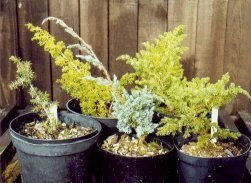 A range of Junipers, all from cuttings. A range of Junipers, all from cuttings.
Taking cuttings produces genetically identical plants. It is therefore of great benefit for the propagation of species that easily hybridise or varieties that revert. It’s also faster than raising plants from seed, especially when larger, semi-hardwood, hardwood or trunk cuttings can be rooted. Success is almost guaranteed, so long as you follow the basic procedures at the correct time of year. Sometimes the rules can be broken with almost equal success, so don’t feel too tied to them. If an opportunity arises to take a few cuttings, give them a try. Prepare a seed tray or pot, filled with a mix of 50% seed compost, composted bark or peat and 50% sharp sand or gravel (no larger than 3mm). You don't need a greenhouse or cold frame, but they certainly help. You can site your cuttings on a windowsill in a room where they will receive good light, but not the strongest sun at midday. Maintain humidity with a propagator top on your seed tray or use a makeshift propagator such as a simple polythene bag inflated around the pot or held up by wire hoops. For improvised propagators, I prefer to recycle 2 litre plastic pop bottles. Each is cut in half to provide close fitting tops for suitably sized plastic pots. 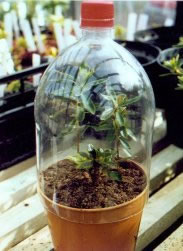 Half a plastic pop bottle used as a propagator Half a plastic pop bottle used as a propagator
The three methods of taking cuttings that are used by gardeners are equally suited to the production of stock for bonsai use. Most cuttings will produce roots all around the stem. From these the ones with the best root arrangement may be selected to produce plants with a good future nebari. SoftwoodSoftwood cuttings generally root quickly in summer, but by their nature are more susceptible to damage from flagging (wilting). It is important to secure material that is young, healthy, firm growth. For most trees and shrubs, a piece that is 5 to 10cm (2" to 4") long is removed from the parent plant and the lower leaves carefully removed, up to about half way along the cutting. It may then be inserted immediately into the compost, but for most species a dip into rooting hormone will improve the strike rate (numbers rooting). If you use the convenient, general purpose, powdered rooting hormone, follow this procedure:- Wet the bottom end of the cutting, shake excess drops off and then dip it into the rooting hormone. Tap to remove any surplus and place it into a small hole in the compost. 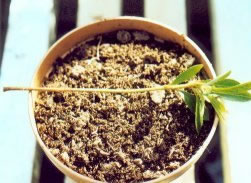 Strip off the lower leaves (this one's a Satsuki azalea) Strip off the lower leaves (this one's a Satsuki azalea)
Liquid hormones are also suitable, just dip the bottom end of the cutting in and allow any surplus to drip back into the jar. Firm the potting mix gently around the cutting and water thoroughly. The pot or tray must then be kept in a moist, close atmosphere. It is a good idea to check the young plants daily and give them a quick misting if they appear to be flagging. The moisture on leaves and stems should help the cuttings recover from wilting until they generate new root systems and the ability to draw in water for themselves. Don't water the compost again until it appears to be starting to dry out. Some slow growers may have to be taken as much shorter cuttings e.g. Chamaecyparis obtusa. 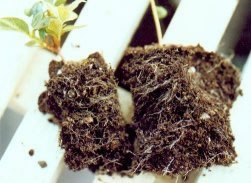 Carefully separate the root mass and pot up, again spreading the roots gently. Some species suited to propagation by softwood cuttings:- Carefully separate the root mass and pot up, again spreading the roots gently. Some species suited to propagation by softwood cuttings:-Abelia easy, Acer easy in early summer, Azaleas tricky - less close atmosphere, Betula difficult, Campanula easy, Cistus easy, Cornus easy, Corokia, Fuchsias easy, Ginkgo, Larix difficult in my experience, Liquidambar, Metasequoia, Prunus, Rhododendron, Ulmus easy, Syringa meyeri 'palibin' difficult. Semi-hardwoodAlso known as half-ripe cuttings. These cuttings consist of growth that has not yet matured fully. They are usually hardening at the base, still flexible further up and are often taken with a heel. The more mature the shoot, the longer it is likely to take to root. The time of year to take this type of cutting varies from plant to plant and from season to season. From July to the end of September is the time that this type are taken. Amelanchier, Azalea, Berberis, Chamaecyparis, Cotoneaster, Cupressus sempervirens with a heel, Escallonia, Ilex, Juniperus with a heel, Nothofagus, Podocarpus with a heel, Pyracantha, Quercus, Syringa, Thuja with a heel and Tsuga with a heel. 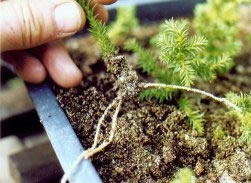 Remove the rooted cutting carefully Remove the rooted cutting carefully  Spread the roots radially as you pot up Spread the roots radially as you pot up
HardwoodHardwood cuttings are made from the mature stems of shrubs and trees. Subjects that may be rooted in this manner are generally easy and root successfully when inserted in garden soil in the open. The spot chosen should be sheltered from winds, weed free and well drained. In autumn take a piece of stem from the current year's growth between 10 to 30cm long, depending upon the plant. They are taken with a heel of older wood if possible. The cutting may be trimmed to remove the long triangle of bark which often comes away with a hardwood heel and any sappy growth at the top. It will be planted to about three quarters of its length. Gardeners used to recommend that all buds below the soil level be rubbed off, but now we are advised that this is counter-productive. Make a trench with a spade, by pushing it into the soil vertically and moving it back and forth to create a V. It is good practice to sprinkle a layer of sharp sand in the bottom of the trench to assist drainage and encourage rooting. Dipping the cuttings into rooting hormone will also help increase the chance of success. Multiple cuttings should be inserted in a trench a few cm apart and if several rows are to be filled the rows should be about 30 cm (12") apart. Replace the soil in each trench as you proceed and tread the surface to secure the stems. Take more cuttings than you require, as many may fail, depending upon the species and winter weather. If you end up with a good strike rate, the surplus can always be swapped. 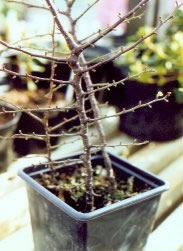 Nothofagus antarctica hardwood cutting, normally done outdoors but this experiment rooted successfully. Nothofagus antarctica hardwood cutting, normally done outdoors but this experiment rooted successfully.
Some species suited to propagation by hardwood cuttings:- Alder, Chamaecyparis, Fig, Forsythia, Gooseberry, Laurel, Honeysuckle, Mulberry, Platanus, Poplar, Willow and Lime. Some Acers, particularly the palmatums favoured for bonsai, are best taken as short hardwood cuttings early in the season and rooted with bottom heat. This allows them to establish and grow on before overwintering. If taken later as softwood they frequently fail, as they are not strong enough for the spring surge in activity. Remove any dead leaves before they decay. Overwinter in well ventilated, clean surroundings. The Yatsubusa's (dwarf palmatum's) are particularly difficult and are better propagated by grafting. Other methods that can be used to great advantage by bonsai workers are:- Trunk CuttingsCertain species successfully root from very thick pieces of stem. This method is, naturally enough, known as taking trunk cuttings. The procedure is to select and cut likely shaped pieces of trunk and remove unwanted branches. Seal all cuts at the top end with wound paste and treat the bottom end with rooting hormone. Plant in sharp, gritty, well drained compost and keep moist. Full light and warmth, in a humid environment, will speed rooting. Some of the species successfully rooted using this method are:- Pomegranate, Willow, Myrtle, Olive, Trident Maple, Japanese Elm and Chinese Elm. I root Pomegranate and Myrtle trunk cuttings successfully in November, placing the pots on a soil warming cable. Experimentation is required to determine the optimum and maximum diameters for each species. Willow trunk cuttings as thick as your thigh root easily if kept damp. 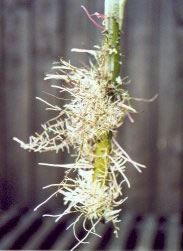 Willow trunk cutting rooted in water. Willow trunk cutting rooted in water.
Root cuttingsAny plant that has the ability to grow buds on its roots can be propagated by root cuttings. Pieces of pencil-thick root, should be lifted and cut into lengths at least 10cm (4") long, with hair roots attached. It is a good practice to cut the bottom end of the root with a sloping cut and the top flat. This is because it is crucial that they are planted the right way up. i.e. The part that was nearest the trunk is at the top of the pot. Root cuttings are best taken in autumn and planted vertically, fairly densely in pots of damp sharp sand, in a cold greenhouse or frame. The top of the cutting should just be visible at the surface, after being watered in. Use a few mm of grit to just cover the surface and the cuttings may then be left, probably until spring. They should not be watered too often as they are more likely to rot if kept wet. In spring they should be carefully inspected. Those that are producing buds may be thinned out as necessary and potted up singly. Species are likely to come true from root cuttings but some varieties will not. Grafted plants roots can be grown but are only likely to be of any use as stock for grafting onto. Variegated or dwarf forms are prone to resuming the more natural growth of the original species. Some species suited to propagation by root cutting are Aesculus, Ailanthus, Aralia, Camellia (in March), Clerodendrum, Chamaecyparis, Malus, Poplar, Prunus, Punica, Pyrus, Syringa and Ulmus Leaf Bud CuttingsThis method is used most frequently for Camellias, where a greater number of plants are wanted from a limited supply of material. In late summer a healthy, vigorous stem with well developed leaves and buds is chosen. This is removed and cut, with a sharp knife, about 2cm (1") below each bud. Each piece must include a leaf and a leaf bud in the axil. The base of the stem can be cut on a slant or bark removed for 1cm (1/2") on one side. The cuttings will usually root without hormone, if placed in a propagator or frame. Species suited to propagation by leaf bud cutting are Camellia, Figs, Mahonia and Grape Vines. Leaf CuttingsAll succulent Crassulas are suited to propagation by leaf cuttings. The method is to break off a healthy leaf, early in the summer, and leave the break to callus over for a week or so. Insert the broken end in sharp, dry sand, leave for a further week and then water minimally until signs of growth are obvious. Succulents rot if over-watered.  Crassula leaf cutting with tiny plantlet developing. Crassula leaf cutting with tiny plantlet developing.
Your first successes with cuttings are a source of tremendous satisfaction. As you progress to more tricky subjects and achieve results with them too, the fun continues. My greenhouses are continually being reorganised to make room for new batches. The problems of space, materials and the time to look after all the young plants become the limiting factors to enthusiastic propagators. All Text & Photographs © Kevin Bailey 1998 - 2008
|